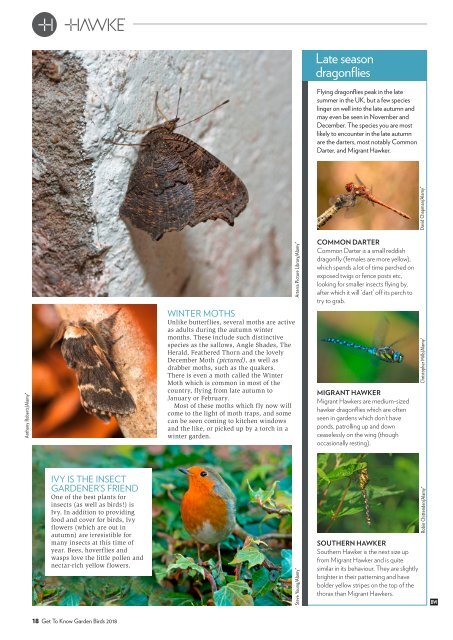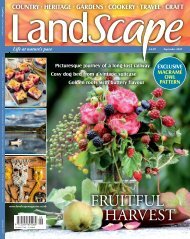You also want an ePaper? Increase the reach of your titles
YUMPU automatically turns print PDFs into web optimized ePapers that Google loves.
Late season<br />
dragonflies<br />
Flying dragonflies peak in the late<br />
summer in the UK, but a few species<br />
linger on well into the late autumn and<br />
may even be seen in November and<br />
December. The species you are most<br />
likely to encounter in the late autumn<br />
are the darters, most notably Common<br />
Darter, and Migrant Hawker.<br />
Anthony Roberts/Alamy*<br />
David Chapman/Alamy*<br />
WINTER MOTHS<br />
Unlike butterflies, several moths are active<br />
as adults during the autumn winter<br />
months. These include such distinctive<br />
species as the sallows, Angle Shades, The<br />
Herald, Feathered Thorn and the lovely<br />
December Moth (pictured), as well as<br />
drabber moths, such as the quakers.<br />
There is even a moth called the Winter<br />
Moth which is common in most of the<br />
country, flying from late autumn to<br />
January or February.<br />
Most of these moths which fly now will<br />
come to the light of moth traps, and some<br />
can be seen coming to kitchen windows<br />
and the like, or picked up by a torch in a<br />
winter garden.<br />
Arterra Picture Library/Alamy*<br />
COMMON DARTER<br />
Common Darter is a small reddish<br />
dragonfly (females are more yellow),<br />
which spends a lot of time perched on<br />
exposed twigs or fence posts etc,<br />
looking for smaller insects flying by,<br />
after which it will ‘dart’ off its perch to<br />
try to grab.<br />
MIGRANT HAWKER<br />
Migrant Hawkers are medium-sized<br />
hawker dragonflies which are often<br />
seen in gardens which don’t have<br />
ponds, patrolling up and down<br />
ceaselessly on the wing (though<br />
occasionally resting).<br />
Christopher Mills/Alamy*<br />
IVY IS THE INSECT<br />
GARDENER’S FRIEND<br />
One of the best plants for<br />
insects (as well as birds!) is<br />
Ivy. In addition to providing<br />
food and cover for birds, Ivy<br />
flowers (which are out in<br />
autumn) are irresistible for<br />
many insects at this time of<br />
year. Bees, hoverflies and<br />
wasps love the little pollen and<br />
nectar-rich yellow flowers.<br />
Steve Young/Alamy*<br />
SOUTHERN HAWKER<br />
Southern Hawker is the next size up<br />
from Migrant Hawker and is quite<br />
similar in its behaviour. They are slightly<br />
brighter in their patterning and have<br />
bolder yellow stripes on the top of the<br />
thorax than Migrant Hawkers.<br />
Robin Chittenden/Alamy*<br />
BW<br />
18 Get To Know Garden Birds 2018

















